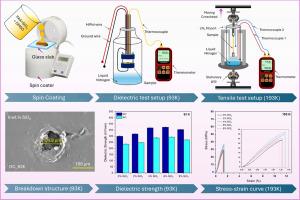Effects of APTES-coated SiO2 nano-fillers on electrical, mechanical, and thermal properties of PAA-based composites for HTS cable insulation at cryogenic conditions
IF 5.7
3区 材料科学
Q2 MATERIALS SCIENCE, MULTIDISCIPLINARY
引用次数: 0
Abstract
Polyamic acid (PAA) is a promising cryogenic dielectric for high-temperature superconductor (HTS) power transmission cables. However, its relatively low dielectric and tensile strengths, along with high thermal contraction, limit its effectiveness. This study develops PAA-based nanocomposites with 3-aminopropyl triethoxysilane (APTES)-coated SiO2 nano-fillers to enhance both dielectric and mechanical properties. Dimethyl sulfoxide (DMSO) was used as a solvent to disperse SiO2, and five compositions were synthesized: pure PAA and PAA with 2–8 wt.% SiO2. The dielectric and tensile strengths of these nanocomposites were evaluated at both room (RT) and cryogenic temperatures. The dielctric constant (ε') and loss tangent (tan δ) were measured in a frequency range of 20 Hz – 2 MHz using an LCR meter at RT. Scanning electron microscopy (SEM) analyzed failure structures, while Fourier transform infrared spectroscopy (FTIR) and thermogravimetric analysis (TGA) characterized their chemical and thermal properties. Results indicate that increasing SiO2 content significantly influences material properties. Among the compositions studied, the 6 wt.% SiO2 nanocomposite exhibited the highest dielectric strength at 93 K, 292.8–373.8 kV/mm, compared to 147.6–193.6 kV/mm at RT. It showed the lowest dielctric contant of 2.61 and loss tangent of 0.015. Additionally, it demonstrated strong mechanical performance at 193 K. The results can be attributed to enhanced interfacial interactions between the surface-coated SiO2 particles and the PAA matrix, which contributes to the improvement in both dielectric and mechanical strength as the filler content increases. The findings highlight the potential of these nanocomposites to improve insulation performance and mechanical reliability in HTS power transmission systems.

低温条件下aptes包覆SiO2纳米填料对高温超导电缆绝缘paas基复合材料电学、力学和热性能的影响
聚酰胺酸(PAA)是一种很有前途的高温超导体(HTS)输电电缆低温介质。然而,其相对较低的介电和拉伸强度,以及高热收缩,限制了它的有效性。本研究开发了以3-氨基丙基三乙氧基硅烷(APTES)包覆SiO2纳米填料的paa基纳米复合材料,以提高介电性能和力学性能。以二甲基亚砜(DMSO)为分散SiO2的溶剂,合成了纯PAA和SiO2含量为2-8 wt.%的PAA。在室温和低温下对这些纳米复合材料的介电强度和拉伸强度进行了评估。在20 Hz ~ 2 MHz的频率范围内,用LCR仪测量了试样的介电常数(ε′)和损耗正切(tan δ),扫描电镜(SEM)分析了试样的失效结构,傅立叶变换红外光谱(FTIR)和热重分析(TGA)表征了试样的化学和热性能。结果表明,SiO2含量的增加对材料性能有显著影响。在所研究的复合材料中,6 wt.% SiO2纳米复合材料在93 K时的介电强度最高,为292.8 ~ 373.8 kV/mm,而室温时介电强度为147.6 ~ 193.6 kV/mm,介电含量最低,为2.61,损耗正切为0.015。此外,它在193 K时表现出较强的力学性能。结果表明,随着填料含量的增加,表面包覆SiO2颗粒与PAA基体之间的界面相互作用增强,从而提高了材料的介电强度和机械强度。研究结果强调了这些纳米复合材料在提高高温超导输电系统的绝缘性能和机械可靠性方面的潜力。
本文章由计算机程序翻译,如有差异,请以英文原文为准。
求助全文
约1分钟内获得全文
求助全文
来源期刊

Materials Research Bulletin
工程技术-材料科学:综合
CiteScore
9.80
自引率
5.60%
发文量
372
审稿时长
42 days
期刊介绍:
Materials Research Bulletin is an international journal reporting high-impact research on processing-structure-property relationships in functional materials and nanomaterials with interesting electronic, magnetic, optical, thermal, mechanical or catalytic properties. Papers purely on thermodynamics or theoretical calculations (e.g., density functional theory) do not fall within the scope of the journal unless they also demonstrate a clear link to physical properties. Topics covered include functional materials (e.g., dielectrics, pyroelectrics, piezoelectrics, ferroelectrics, relaxors, thermoelectrics, etc.); electrochemistry and solid-state ionics (e.g., photovoltaics, batteries, sensors, and fuel cells); nanomaterials, graphene, and nanocomposites; luminescence and photocatalysis; crystal-structure and defect-structure analysis; novel electronics; non-crystalline solids; flexible electronics; protein-material interactions; and polymeric ion-exchange membranes.
 求助内容:
求助内容: 应助结果提醒方式:
应助结果提醒方式:


